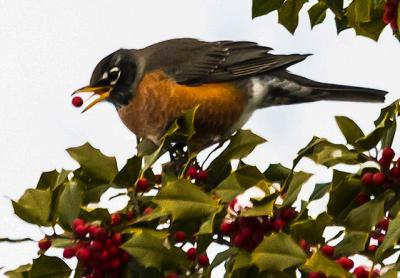Nature Notes: Of Birds and Berries

We are not out of the woods yet. It is still cold and the birds that have been showing up at your feeder daily will still need another couple of weeks of food to keep them going. In the past, very few people fed birds, and if they did, it was likely to be something not nutritious like Wonder Bread. Not as many birds stayed around during the winter, and those that did were either raptors or owls that fed on mice and other small mammals, or those vegetarians that searched far and wide for scattered seeds, cedar berries, and the like.
In the old days there were far fewer houses, far fewer lawns, more farm fields and more over-wintering fruit such as holly berries and bayberries. In many quarters, privets and bittersweet have replaced the native fruit bearers, and, while some birds will eat the foreign berries, they would prefer the native ones.
Parts of the South Fork are known for their hedge-fronted houses. This is especially true of the houses south of the highway where there are hedges galore, usually tall and well kept. These hedges are generally made up of privets, the number one hedge plant of all time. Lately, however, arborvitae hedges are springing up throughout the area. Arborvitae are related to our native eastern red cedars, but their berries are not sought after like those of the native plants. There are still a few native red cedar and white hedges, but they have a hard time handling the road salt put down to prevent freezing and black ice during the winter.
There are many native fruit-producing species that could take the place of the arborvitae and privet hedges, but they are not in demand because they are not as well comported as the latter and they leave spaces that one can see through during drive-bys. So, as we progress into the new millennium, we see more and more hedges and fewer and fewer native fruit trees and old fields with their winter standing crop of goldenrod and seeds from several grasses.
Very few politicians use the word rural to describe the South Fork. The word has become synonymous with no progress, even regression. As the old folks peel away and are replaced by the millennials, many native species, rustic gates, porches with settees, and detached garages are considered old fashioned and are to be avoided. In the last century about half the houses sported grape arbors and fruit trees. But they require attention and nowadays while trying to make a living and keeping up socially, who has time to fuss with such fancies?
Those houses that still live in the past and have hollies, eastern red cedars, still attract birds and supply needed and nutritious foodstuffs. Frankly, the birds outside my window, which chow down every day from dawn to dusk, do not complain about a diet of nearly 100 percent sunflower seeds. Sunflower seeds are tasty and nutritious — humans enjoy them as well — but berries supply certain elements that sunflower seeds lack. You will almost never see a robin, bluebird, catbird, or mockingbird take a sunflower seed. They are strictly fruit and berry eaters in the winter months.
Hollies and junipers are particularly good for those species that do not eat seeds. Female hollies replete with red berries are a sight for sore eyes after a big winter storm covers the ground. Not only do the birds take advantage of these late-fruiting species, the trees also fare well. The birds that feed on their fruit defecate their seeds and many of those seeds germinate to become seedlings come spring. This is a process known as co-evolution and it is widespread.
But who has time to nurture such goings-on? We have to keep up with what’s going on or, for many of us, just keep afloat in a haywire world headed into deep entropy. But for many of us nature lovers, the sight of a bluebird stealing a holly berry or a robin ensconced in an eastern red cedar tree feeding on the berries for an hour or more while sheltered from the wind by the thick covering of tiny juniper needles helps us get through the winter. We, along with the bluebird and robin, know that spring is on its way and we take comfort in that vision.
Which is better, progression or regression? Some of each keeps us in touch with the past and helps us get on in the future.
Larry Penny can be reached via email at [email protected].
